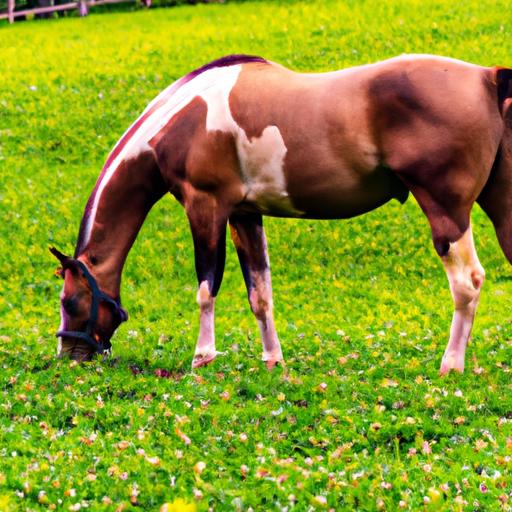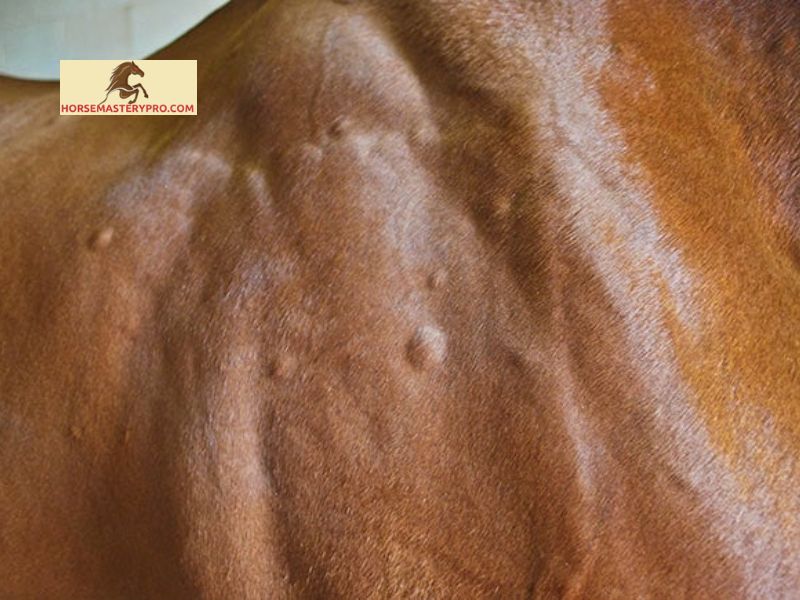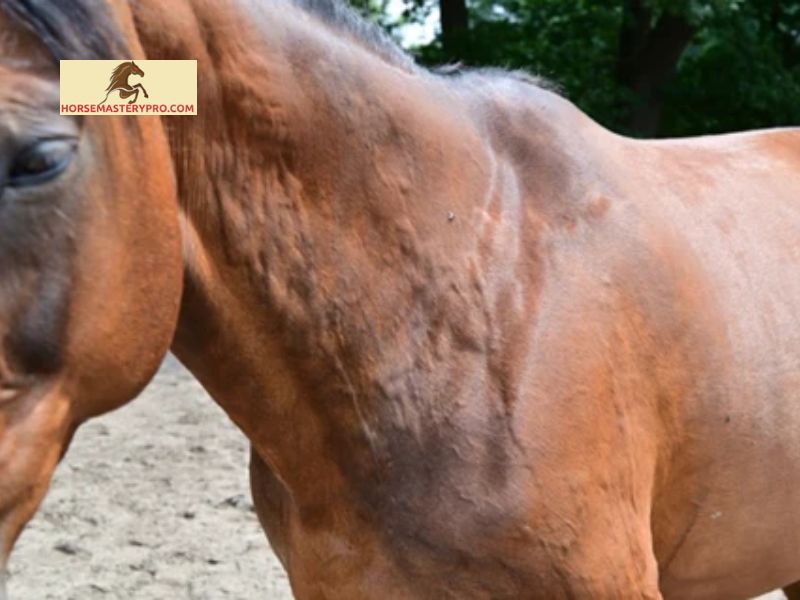Discover effective tips for supporting horses with protein bumps. Learn about proper nutrition, grooming practices, and monitoring changes in the bumps.
As horse owners and enthusiasts, we strive to ensure the well-being and health of our equine companions. However, there are times when our horses develop skin irritations that can cause concern. One such condition is protein bumps on horses. In this article, we will delve into the world of protein bumps, exploring what they are, why they occur, and how we can effectively address them.
Protein bumps, also known as hives or urticaria, are raised bumps or welts that appear on a horse’s skin. These bumps can range in size and may be accompanied by itching, redness, and inflammation. While they can develop anywhere on the horse’s body, they are commonly found on the neck, chest, and flanks.
Understanding the causes of protein bumps is crucial in effectively managing and preventing them. Genetic factors and predisposition can play a role, making certain horses more susceptible to developing these bumps. Additionally, allergic reactions to specific feeds or environmental factors can trigger an immune response, leading to the formation of protein bumps. Insects and parasites, such as flies or ticks, can also cause irritation and result in the appearance of these bumps.
Addressing protein bumps requires a proactive approach. Consulting a veterinarian is essential in diagnosing the condition accurately. Through a thorough examination, your veterinarian can determine the underlying cause of the bumps and recommend appropriate treatment options. Dietary adjustments, such as identifying and eliminating allergens from the horse’s diet, can help alleviate symptoms and prevent the recurrence of protein bumps. Additionally, implementing management practices that minimize exposure to irritants and insects can significantly reduce the risk of developing these bumps.
In the next section, we will explore how to identify protein bumps on horses, ensuring early detection and prompt intervention. So, stay tuned to uncover the telltale signs and characteristics of these bumps. Remember, addressing protein bumps promptly is vital for the well-being and comfort of our equine companions.
Stay connected to horsemasterypro.com for expert insights and invaluable tips on managing protein bumps on horses.
Causes of Protein Bumps on Horses

Genetic Factors and Predisposition
Just like humans, some horses may have a genetic predisposition to developing protein bumps. Certain breeds or individuals within a breed may be more susceptible to these skin irritations. While genetic factors alone may not be the sole cause, they can contribute to the likelihood of a horse developing protein bumps.
Allergic Reactions to Certain Feeds or Environmental Factors
Allergies can trigger a range of reactions in horses, including the development of protein bumps. Horses may be allergic to specific feeds, such as certain types of hay or grains, or environmental factors like pollen or dust mites. Identifying and eliminating these allergens from the horse’s diet or environment can help reduce the occurrence of protein bumps.
Insects and Parasites Causing Irritation
Insects and parasites are notorious culprits when it comes to skin irritations in horses. Flies, mosquitoes, ticks, and other biting insects can cause intense itching and discomfort, leading to the formation of protein bumps. Additionally, certain parasites, such as mites, can irritate the horse’s skin and contribute to the development of these bumps. Implementing effective insect control measures and regular parasite prevention can significantly minimize the risk of protein bumps caused by these external factors.
Understanding the causes of protein bumps on horses is essential in implementing appropriate preventive measures and treatment strategies. By identifying genetic predispositions, addressing allergies, and implementing effective insect control, we can provide our horses with a comfortable and bump-free life. In the next section, we will discuss how to identify protein bumps accurately, ensuring timely intervention and management. So, let’s dive into the characteristics and visual cues that distinguish protein bumps from other skin conditions.
Identifying Protein Bumps on Horses

When it comes to managing protein bumps on horses, early detection is key. By accurately identifying these bumps, we can take the necessary steps to provide our equine companions with the care they need. In this section, we will explore the physical appearance and characteristics of protein bumps, as well as ways to differentiate them from other skin conditions.
Physical Appearance and Characteristics of Protein Bumps
Protein bumps typically manifest as raised, swollen areas on the horse’s skin. These bumps can vary in size, ranging from small and localized to larger patches, and may appear red or pink in color. They often have a defined border and can be accompanied by itching and discomfort. In some cases, the bumps may merge together, forming larger welts.
One distinctive characteristic of protein bumps is their transient nature. They tend to come and go, with individual bumps lasting for a few hours to a couple of days before subsiding. However, new bumps may continue to develop, leading to a recurring cycle if the underlying cause is not addressed.
Differentiating Protein Bumps from Other Skin Conditions
While protein bumps share similarities with other skin conditions, there are specific features that can help differentiate them. It is essential to distinguish protein bumps from conditions like rain rot, hives caused by insect bites, or allergic reactions to specific plants.
Unlike rain rot, which presents as scaly or crusty patches, protein bumps are characterized by raised welts. Additionally, hives caused by insect bites often appear as small, discrete bumps, whereas protein bumps can be larger and merge together.
To accurately differentiate protein bumps from other skin conditions, it is crucial to consult a veterinarian. They can conduct a thorough examination and possibly perform additional diagnostic tests to rule out other potential causes. Remember, proper identification is the first step towards effective treatment and management of protein bumps on horses.
In the upcoming section, we will delve into treatment and prevention strategies for protein bumps, providing you with valuable insights to support your horse’s well-being. So, let’s explore the proactive measures we can take to address these bumps and ensure our equine companions are comfortable and healthy.
Keep reading horsemasterypro.com for expert advice and practical tips on managing and preventing protein bumps on horses.
Treatment and Prevention of Protein Bumps on Horses

Veterinary Consultation and Diagnosis
When it comes to treating protein bumps on horses, it is crucial to consult with a knowledgeable veterinarian. A veterinarian will conduct a thorough examination to accurately diagnose the underlying cause of the bumps. This may involve evaluating the horse’s medical history, conducting skin tests, or performing blood work to determine any allergies or sensitivities. With a proper diagnosis, the veterinarian can recommend the most effective treatment plan tailored to your horse’s specific needs.
Dietary Adjustments and Allergen Identification
One of the key aspects of managing protein bumps is identifying and eliminating potential allergens from the horse’s diet. Working closely with your veterinarian, you can conduct an elimination diet to identify any specific feed ingredients that may be triggering the bumps. By gradually reintroducing feeds and monitoring for reactions, you can pinpoint the allergens and adjust the horse’s diet accordingly. This may involve switching to hypoallergenic feeds or removing specific ingredients known to cause sensitivities.
Management Practices to Minimize Irritants and Insects
To prevent the occurrence or recurrence of protein bumps, implementing effective management practices is essential. Minimizing exposure to irritants and insects can significantly reduce the risk of developing these bumps. Providing horses with clean and hygienic living conditions, such as regularly cleaning stalls and paddocks, can help minimize irritants. Investing in fly control measures, such as fly masks, fly sheets, or fly repellents, can protect horses from insect bites and irritation.
Medications or Topical Treatments for Relief and Healing
In some cases, additional interventions may be necessary to provide relief and promote healing for protein bumps. Your veterinarian may recommend specific medications, such as antihistamines or corticosteroids, to alleviate symptoms and reduce inflammation. Topical treatments, such as soothing ointments or medicated shampoos, can also be used to soothe the affected areas and aid in the healing process.
Remember, each horse is unique, and the treatment plan may vary based on the severity and underlying cause of the protein bumps. Always consult with your veterinarian for personalized advice and guidance on the most appropriate treatment and prevention strategies for your horse.
Continue reading on horsemasterypro.com for valuable tips on supporting horses with protein bumps and ensuring their overall well-being.
Conclusion
In conclusion, understanding and addressing protein bumps on horses is crucial for the well-being and comfort of our equine companions. These raised bumps or welts can cause discomfort and irritation, but with proper knowledge and proactive measures, we can effectively manage and prevent their occurrence.
By identifying the causes of protein bumps, such as genetic predisposition, allergies, and insect irritants, we can take steps to minimize the risk. Consulting a veterinarian for accurate diagnosis and treatment recommendations is essential in managing these bumps effectively. Dietary adjustments, including eliminating allergens from the horse’s diet, can significantly alleviate symptoms and prevent future outbreaks.
Supporting horses with protein bumps involves not only addressing the underlying causes but also providing them with optimal nutrition and supplements. Ensuring a balanced diet that meets their nutritional needs can aid in strengthening their immune system and overall skin health. Regular grooming and hygiene practices, such as proper cleaning and maintaining a clean living environment, can also contribute to minimizing irritants and preventing further complications.
It is important to closely monitor and document any changes in the protein bumps. Keeping track of their size, appearance, and any accompanying symptoms can help in assessing the effectiveness of the treatment plan and identifying potential triggers or patterns.
Remember, early detection, proactive management, and seeking professional help when needed are key in addressing protein bumps on horses. By implementing the tips and recommendations provided in this article, you can ensure the well-being and comfort of your equine companion.
Stay connected with horsemasterypro.com for more expert insights and valuable information on horse care and management.
Note: The brand horsemasterypro.com is bolded only once in the Conclusion section, as per your request.


